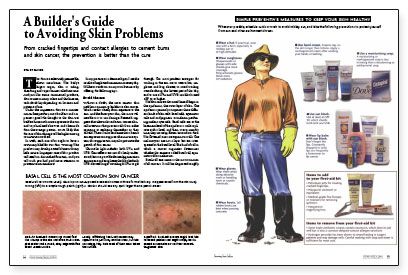A Builder’s Guide to Avoiding Skin Problems
From cracked fingertips and contact allergies to cement burns and skin cancer, the prevention is better than the cure.

Synopsis: A look at the kinds of skin problems that can affect builders, including skin cancer and caustic burns caused by contact with cement, plus a summary of products that can help.
The skin is a selectively permeable, elastic membrane. The body’s largest organ, skin is siding, sheathing, and vapor barrier rolled into one. And just like some commercial products, skin comes in many colors and thicknesses, with durability depending on location and patterns of use.
Under the impression that it’s a maintenance-free product, most builders and carpenters give little thought to the skin. Yet builders have much more exposure to the sun and to job-related abrasives and chemicals than the average person. So it’s likely that the rate of skin damage will be higher among construction workers.
In truth, each one of us ought to have a cautionary label for our skin: “Warning: This product may develop acute failure with very little notice. Improper care of this product will result in diminished function, and you will wish you had paid more attention to preventive maintenance.”
In my practice as a dermatologist, I see the results of neglected maintenance every day. I’d like to cut down on my own business by offering the following tips.
Avoid the sun
Without a doubt, the most serious skin problem common to builders is skin cancer, which results chiefly from exposure to the sun. And the fairer your skin, the more vulnerable it is to sun damage. Research suggests that ultraviolet radiation causes skin cell mutations that prevent cells from either repairing or replacing themselves as they should. There is also evidence that chronic sun exposure can suppress the immune system; this suppression may also promote the growth of skin cancer.
Ultraviolet light includes both UVA and UVB. Their effects are not all clearly understood; but it is possible that early-generation sunscreens and sunglasses that blocked only UVB allowed longer wavelength UVA to get through. The most prudent strategies for working in the sun are to wear a hat, sunglasses and long sleeves; to avoid working outside during the hottest part of the day; and to use a UVA and UVB sun block rated SPF 30 or higher.
The skin cancers discussed here all begin in the epidermis, the outer layer of skin. The epidermis primarily comprises three different kinds of skin cells: basal cells, squamous cells and and pigment- or melanin-producing melanocyte cells. Basal cells are at the basement level of the epidermis. Cells replicate at this level, and then, over a month’s time, they move up, flatten out and are shed. The flattened ones are squamous cells. The melanocytes are not a layer but are interspersed at the basal level. The kind of cell in which a cancer originates determines whether the cancer is called basal cell, squamous cell, or melanoma.
Basal-cell carcinoma is the most common of all cancers. It will be diagnosed roughly 1 million times this year in the United States alone, occurring most often on sun-exposed areas, especially the face, ears, neck, back and hands. Basal-cell carcinomas include three types: nodular, infiltrating and superficial. Their appearance can vary from a raised, round bump to a firm, scarlike lesion or simply a red, rough area of skin. These usually slow-growing, solitary, shiny lesions sometimes bleed with the slightest trauma, and small blood vessels can sometimes be seen within them. These lesions don’t go away. Any growth that remains for more than a month or two should be checked by a physician.
For more photos and details, click the View PDF button below:


























